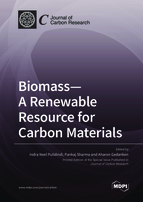Biomass—a Renewable Resource for Carbon Materials
A special issue of C (ISSN 2311-5629). This special issue belongs to the section "Carbon Materials and Carbon Allotropes".
Deadline for manuscript submissions: closed (23 February 2023) | Viewed by 20861
Special Issue Editors
Interests: carbon materials; biomass conversion; biofuels; electrochemistry
Special Issues, Collections and Topics in MDPI journals
Interests: carbon dioxide absorption
Special Issues, Collections and Topics in MDPI journals
Interests: nanomaterials; carbon nano
Special Issues, Collections and Topics in MDPI journals
Special Issue Information
Dear Colleagues,
During the last decade (2010–2020), there has been a prolific growth in research in the field of “Carbon materials from biomass”. A Web of Science search with the keywords “biomass” and “carbon materials” has shown a steady rise in the number of research publications in this field.
This trend is expected to grow owing to the depletion of fossil-based resources that served as feedstock for activated carbon materials thus far. Lignocellulosic biomass, including forest, agricultural and marine waste, are a substitute for fossil-based resources for carbon material production. Carbon materials with astounding properties and sometimes even superior to those of commercial activated carbon materials derived from fossil-based resources can be produced form biomass.
As the demand for high surface area, heteroatom functionalized micro and mesoporous activated carbon materials is growing due to their application in the fields of environment, energy, agriculture, sensing, catalysts, industry, defence and health sectors, there is an urgent need to focus on exploring the biomass feedstock as a sustainable feedstock for carbon materials production. Likewise, innovation is expected in the atomic level characterization of these materials to gain new insight into their property, structure and application. It is therefore an earnest appeal to the research fraternity in the field of “Carbon materials from biomass” to contribute their research papers actively for publication in the Special Issue, namely, “Biomass- A Renewable Resource for Carbon Materials” in the journal C—Journal of Carbon Research.
Dr. Indra Neel Pulidindi
Dr. Pankaj Sharma
Prof. Dr. Aharon Gedanken
Guest Editors
Manuscript Submission Information
Manuscripts should be submitted online at www.mdpi.com by registering and logging in to this website. Once you are registered, click here to go to the submission form. Manuscripts can be submitted until the deadline. All submissions that pass pre-check are peer-reviewed. Accepted papers will be published continuously in the journal (as soon as accepted) and will be listed together on the special issue website. Research articles, review articles as well as short communications are invited. For planned papers, a title and short abstract (about 100 words) can be sent to the Editorial Office for announcement on this website.
Submitted manuscripts should not have been published previously, nor be under consideration for publication elsewhere (except conference proceedings papers). All manuscripts are thoroughly refereed through a single-blind peer-review process. A guide for authors and other relevant information for submission of manuscripts is available on the Instructions for Authors page. C is an international peer-reviewed open access quarterly journal published by MDPI.
Please visit the Instructions for Authors page before submitting a manuscript. The Article Processing Charge (APC) for publication in this open access journal is 1600 CHF (Swiss Francs). Submitted papers should be well formatted and use good English. Authors may use MDPI's English editing service prior to publication or during author revisions.
Keywords
- carbon materials from biomass
- activated carbon materials from biomass
- physical, chemical and electrochemical methods of activation
- methods of preparation of activated carbon materials from biomass
- nanoachitecture of carbon materials from biomass
- tuning of textural properties of carbon materials from biomass
- tuning of structural and morphological properties of carbon materials from biomass
- application in biofuels production
- application in electrode material production for electrochemical device (battery, supercapacitor, fuel cells)
- application as adsorbents for CO2
- application as adsorbents for toxic heavy metals
- carbon composites
- graphene analogues from biomass
- heteroatom (N, S, O) functionalized carbon materials from biomass
Related Special Issue
- Biomass—a Renewable Resource for Carbon Materials (2nd Edition) in C (10 articles)








